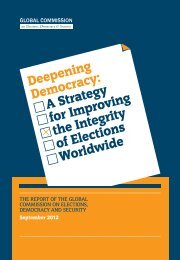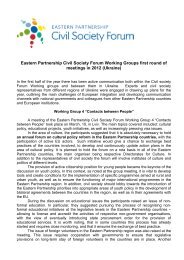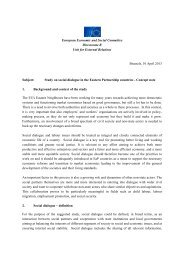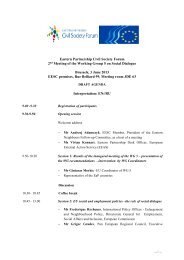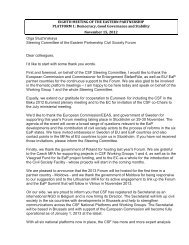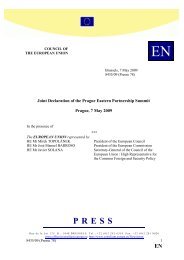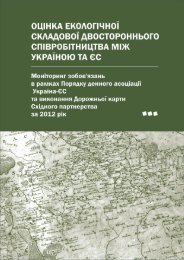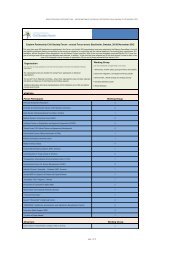Non-formal education - Eastern Partnership Civil Society Forum
Non-formal education - Eastern Partnership Civil Society Forum
Non-formal education - Eastern Partnership Civil Society Forum
You also want an ePaper? Increase the reach of your titles
YUMPU automatically turns print PDFs into web optimized ePapers that Google loves.
– Tools of trade unions and employers;<br />
– Funds of economic entities – at least 2% of payroll of a company in accordance with Art. 213<br />
of the Labor Code of the Republic of Moldova;<br />
– Own funds of the customer of <strong>education</strong>;<br />
– Other financial assets under the law.<br />
By signing memorandum of the Commission of the European Council on LLL (2000), Republic<br />
of Moldova has committed to provide public access to <strong>education</strong> and human resource development.<br />
Based on this, steps are taken to ensure that the responsible and stakeholders, institutions, individuals<br />
develop the state, non-profit and commercial possibilities of non-<strong>formal</strong> <strong>education</strong>.<br />
At the same time we can noticea low level of population covered / availability by institutions of non<strong>formal</strong><br />
<strong>education</strong> (level of the regional center, regional, urban / rural, etc.)<br />
The observation is based on the following information of demographic, social and competence<br />
character: according to the National Bureau of Statistics, on January 1, 2012 permanent population<br />
was 3,559,500 people, 3.3 thousand less than at the beginning of 2010. Moldova continues to be a<br />
country with the lowest level of urbanization in Europe: 41.6% of the population lives in urban areas<br />
and 58.4% – in villages. According to the classification by sex, men make up 48%, women – 52% of<br />
the total population.<br />
Population by main age groups is characterized by the following-relator ages: 17.8% are under<br />
working age, 66.7% – in the working age,and 15.5% – above working age.<br />
Analysis of the age structure of the population indicates the intensification of the process demographic<br />
aging of society. Aging factor is 14.4%.Proportion of the adult population in rural areas to urban areas<br />
is 1.5 times. About 15.2% of the rural population has exceeded the age of 60, while the total number of<br />
female rural population of elderly women is 18, 1%. (www.statistica.md)<br />
Reducing the number of working-age population and the increase in the average-age workers in<br />
the national economy has a complex impact on the socio-economic development with direct impact<br />
on the overall supply of labor, investments, income distribution, public spending on social security and<br />
others; continued aging of the population leads to the appearance of serious drawbacks in the human<br />
capital needed for sustainable development.<br />
Also, it should be noted that social problems appeared simultaneously with the development<br />
of migration processes and increasing poverty. Children, whose parents are in labor migration, are<br />
remained in the care of relatives and exacerbate the need for their involvement in further <strong>education</strong>.<br />
If in 2010 in Moldova poverty decreased in by 6.0 points or percentage (30.3% of population)<br />
compared to the year 2009, the level of poverty in the country has grown during economic recession<br />
in 2011-2012. 80% of the country’s poor people live in rural areas, the most vulnerable segment of<br />
the welfare and security. Another poorly protected category of the population are children, especially<br />
those living in rural areas (38% vs. 13% in urban areas 48 ).These statements explain why the costs /<br />
investments population of the Republic of Moldova invest in <strong>education</strong> is less than 1% of their annual<br />
income. <strong>Non</strong>-<strong>formal</strong> <strong>education</strong>, in essence, is the low-budget, and increases access to <strong>education</strong> for<br />
disadvantaged groups of population.<br />
An important aspect of determining the degree of demand for non-<strong>formal</strong> <strong>education</strong> is the learning<br />
motivation.<br />
Based on the survey data of this aspect, 65% of respondents (adults) indicated their need for<br />
training as high.<br />
On the question of the need for continuing <strong>education</strong>:<br />
– 65% of respondents said about professional training component,<br />
– 17% – social and civic,<br />
– 18% – parent and family <strong>education</strong>.<br />
– 67% of respondents choose <strong>formal</strong> training – courses, 26% – prefer to share their experiences<br />
and only 3% of respondents chose the non-<strong>formal</strong> forms of training and are ready for selflearning.<br />
It should be noted that the study was conducted several years ago, but still, in general,<br />
the findings support the need to promote the opportunities of non-<strong>formal</strong> <strong>education</strong> in the<br />
71




